
The Batesville Historic District is a national historic district located at Batesville, Albemarle County, Virginia. In 1999, when it was listed on the National Register of Historic Places, it included 33 buildings deemed to contribute to the historic character of the area. They include representative examples of the early-19th century Federal Style, the mid-19th century Greek Revival Style, simple late-Victorian styles from the late-19th century- and early-20th century, Classical Revival and Colonial Revival styles. Notable buildings include the Batesville Elementary School (1922), Batesville Public School, Mount Ed Baptist Church, Batesville Methodist Church (1861), Dr. Smith House, the Barskdale House, Hill House, and Page's Store.
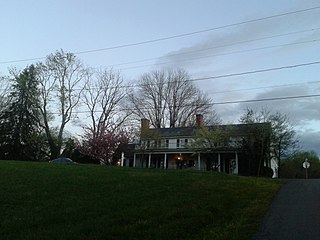
Cartersville Historic District is a national historic district located at Cartersville, Cumberland County, Virginia. It encompasses 51 contributing buildings and 2 contributing sites in the village of Cartersville. Most of the buildings date to the turn of the 20th century, with a number of late-18th- and 19th-century dwellings and former taverns, two churches, a few commercial buildings, a post office, and a former school. Notable buildings include the Deanery (1780s), Glaser House (1790s), Baptist Parsonage (1790s), Cartersville Tavern, Cartersville Baptist Church, St. Catherine's Catholic Church (1910), Cartersville Methodist Episcopal Church (1883), Cartersville Post Office (1910), Cartersville Bank, Culbertson House, H. T. Harrison House, and W. E. Robinson House, Newstead Manor.

West Point Historic District is a national historic district located at West Point, King William County, Virginia. The district encompasses 75 contributing buildings and 1 contributing object in the town of West Point. The district includes residential, commercial, and institutional buildings and is notable for its variety of late-19th- and early-20th-century styles and building types. Notable buildings include the William Mitchell House, Anderson-Mayo House, Ware House, St. John's Episcopal Church (1882), Mt. Nebo Baptist Church (1887), West Point United Methodist Church (1889), O'Connor Hotel and annex, Treat-Medlin House (1898), Gouldman House (1923), First Baptist Church (1926), U.S. Post Office (1931), West Point Town Office Building, Citizens and Exchange Bank (1923), and Beverly Allen School (1930s).

Rapidan Historic District is a national historic district located at Rapidan, in Culpeper County and Orange County, Virginia. It encompasses 34 contributing buildings in the crossroads village of Rapidan. They include three churches, a post office, a commercial building, one meeting hall, two railroad depots, twenty-one residences, and six outbuildings. Notable buildings include the Emmanuel Episcopal Church (1874), "Annandale", the Rapidan Trading Post (1903), Rapidan Post Office (1914), Lower Rapidan Baptist Church (1914), Rapidan Passenger Depot, and the Peyton-Grhby House. Also located in the district is the separately listed Waddell Memorial Presbyterian Church.

Hume Historic District is a national historic district located at Hume, Fauquier County, Virginia. It encompasses 59 contributing buildings in the rural village of Hume. The majority of the buildings in the district are vernacular in nature and are late-19th- to early- 20th-century frame dwellings of the side-passage and I-house form. It also contains three commercial buildings, a church, two schools, and a former tavern. Notable buildings include Barbee's Tavern, "The Dell," the parsonage for Leeds Church, former Captain Marshall's Store, the African-American Hume School, the former Hume Methodist Church, and the Hume Baptist Church (1921).

Marshall Historic District is a national historic district located at Marshall, Fauquier County, Virginia. It encompasses 314 contributing buildings and 3 contributing sites in the rural village of Marshall. The district represents a collection of historic buildings with a wide range of building types and architectural styles that date from the end of the 18th century to the mid-20th century. Notable buildings include the Fauquier Heritage and Preservation Foundation building, hosteller's house for Rector's Ordinary, a store and Confederate post office, the Elgin House, former Marshall Pharmacy, the Foley Building, the Gothic Revival style Trinity Episcopal Church (1849), Salem Baptist Church (1929), Marshall United Methodist Church (1899), and the Marshall Ford Company (1916), reputed to be the oldest building built as a Ford dealership in the United States that is still functioning as such.
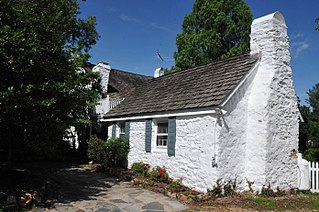
Rectortown Historic District is a national historic district located at Rectortown, Fauquier County, Virginia. It encompasses 76 contributing buildings, 3 contributing sites, and 2 contributing structures in the rural village of Rectortown. The district includes dwellings dating back to the 18th century, churches, a school, an Odd Fellows hall, a post office, multiple commercial buildings, and several cemeteries that illustrate the town's growth and development. Notable buildings include the Maidstone Ordinary, the Rector-Slack Log House, the Ashby House, the Georg Mann House, The Brick Store House, Rector's Warehouse and Station, Denham, Maidstone, Rectortown United Methodist Church (1894), the Jackson-Grant House (1924), Slack's Store (1890), and the Mt. Olive Odd Fellows Lodge (1935).

Town of Halifax Court House Historic District is a national historic district located at Halifax, Halifax County, Virginia. The district includes 172 contributing buildings, 1 contributing site, 13 contributing structures, and 1 contributing object in the Town of Halifax. Resources include government, commercial, residential, religious, educational and industrial buildings that date from the early-19th Century to the mid-20th century. Notable buildings include the Rice House, Edmunds/Lewis Office (1869), People's Bank, Beth Car Baptist Church (1892), Christ Episcopal Church, Saint Luke's Christian Methodist Episcopal Church, Dr. Carter House, County Office Building (1915), Town of Halifax Swimming Pool (1930s), Municipal Building/ Fire Station (1950), Halifax Roller Mills (1915), Halifax Planing Mill, Halifax Department Store (1949), and Randolph Theater. Also located in the district is the separately listed Halifax County Courthouse.

Round Hill Historic District is a national historic district located at Round Hill, Loudoun County, Virginia. It encompasses 204 contributing buildings, 1 contributing site, and 1 contributing structure in the town of Round Hill. It includes a variety of residential, commercial, and institutional buildings, with the majority built between 1880 and 1920. Notable buildings include the Gregg-Parks-Potts House, Guilford Gregg Store, Sagamore Hall, James Copeland House (1886), Hibbs House, African Methodist Church (1892), Mount Zion Baptist Church, Round Hill Baptist Church, Round Hill United Methodist Church, Castle Hall, Ford's Store, Round Hill Grocery, and the former Round Hill Railroad Depot (1902).
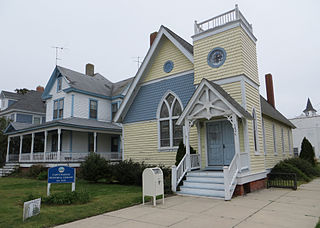
Cape Charles Historic District is a national historic district located at Cape Charles, Northampton County, Virginia. The Town was surveyed by the Virginia Department of Historic Resources in 1989, and a National Register Historic District was created and listed on the National Register of Historic Places.

Blackstone Historic District is a national historic district located at Blackstone, Nottoway County, Virginia. It encompasses 272 contributing buildings and 1 contributing structure in the town of Blackstone. They include residential and commercial structures dating from the late-18th to early-20th centuries. They include notable examples of the Late Gothic Revival, Queen Anne, and Romanesque styles. Notable buildings include the former Blackstone College for Girls (1922), First National Bank, Thomas M. Dillard House, Richmond F. Dillard House, Blackstone Public School Complex, Bagley House (1911), James D. Crawley House (1903), Blackstone Baptist Church (1907), Crenshaw United Methodist Church (1903), St. Luke's Episcopal Church (1916), and Blackstone Presbyterian Church (1901). The James D. Crawley House was designed by J. E. McDaniel, who was a local architect. Located in the district is the separately listed Schwartz Tavern.

Stuart Uptown Historic District is a national historic district located at Stuart, Patrick County, Virginia. The district includes 18 contributing buildings and 1 contributing object in the central business district of the town of Stuart. The district includes a variety of commercial and governmental buildings including the Stuart Post Office constructed by the Public Works Administration in 1940, the Patrick County Bank (1911), Bank of Stuart (1896), Stuart United Methodist Church and the Stuart Baptist Church. The district includes one and two-story brick commercial buildings dating from the early to mid 20th century including the Stuart Drug Store (1938) and the Hudson's Drug Store (1941). Located in the district and separately listed is the Patrick County Courthouse.

Bridgewater Historic District is a national historic district located at Bridgewater, Rockingham County, Virginia. The district encompasses 127 contributing buildings and 1 contributing site in the central business district and surrounding residential areas of the town of Bridgewater. It includes a variety of residential, commercial, and institutional buildings most of which date from the 19th century and early-20th century. Notable buildings include the Jacob Dinkle House, the St. Claire Kyle House, the J. G. Brown House, Dr. T. H. B. Brown House, the Hite House, Childress House, Whitmore House, the O. W. Miller House, Dr. Strickler House, Masonic Lodge, Methodist Church (1841), Baptist Church, Farmer's Bank, Berlin Building (1883), Geary Building (1887), and the Lutheran Church (1881). Also included is the oldest portion of the Bridgewater College campus, consisting of five fine brick collegiate buildings constructed before 1911.
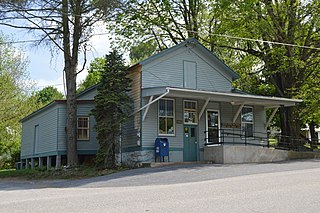
Singers Glen Historic District is a national historic district located at Singers Glen, Rockingham County, Virginia. The district encompasses 65 contributing buildings and 2 contributing sites in the village of Singers Glen. The district retains much of its late 19th-century air and most of its original buildings. Notable buildings include the Glen Farm, The Solomon Funk Farm, Edwin E. Funk House, Swank Store and Post Office, T. Funk and Sons Store (1895), The Carriage Works (1826), Singers Glen Baptist Church (1888), United and Methodist Church. Located in the district is the separately listed Joseph Funk House.
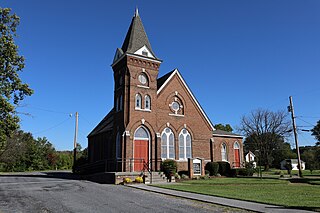
Riverton Historic District is a national historic district located at Front Royal, Warren County, Virginia. The district encompasses 66 contributing buildings and one contributing site in the town of Front Royal. It is a primarily residential district with buildings dating from the mid-19th century and including a diverse collection of building types and architectural styles. Notable buildings include Lackawanna (1869), the Old Duncan Hotel, the Riverton United Methodist Church (1883-1890), Dellbrook, the Carson Lime Company worker's houses, and the Old Riverton Post Office and Grocery. Located in the district and separately listed is Riverside.

Hampton Downtown Historic District is a national historic district located at Hampton, Virginia. The district encompasses 25 contributing buildings and 7 contributing sites in the central business district of Hampton. The district includes a variety of commercial, residential, institutional, and governmental buildings dating from the late-19th to mid-20th century. There are notable examples of the Beaux-Arts, Art Deco, and Gothic Revival styles. Notable buildings include First United Methodist Church, the Sclater Building (1871), St. Tammany's Masonic Lodge (1888), Hampton Baptist Church (1883), Old Hampton Station Post Office (1914), and the circuit courthouse (1876). Located in the district and separately listed are St. John's Episcopal Church (1728) and the former Hampton City Hall (1939).

Poplar Lawn Historic District is a national historic district located at Petersburg, Virginia. The district is named after Petersburg's central park which was often a military parade ground in the early 19th century, but became a tent-based detention center and hospital during the American Civil war and later became the site of civic celebrations, including possibly the first Memorial Day, on June 9, 1865. The district also includes 372 contributing buildings, mostly mid- to late-19th-century, single-family residences for middle and upper-middle-class families, some constructed of brick, others weatherboard frame, and later subdivided. Residential architectural styles include Greek Revival, Colonial Revival, Second Empire, and Italianate. Notable buildings include the Bolling-Zimmer House, St. Stephen's Church, Zion Baptist Church, William T. Double House, the Waterworks (1856), Dr. Robert Broadnax House (1858), Market Street Methodist Church Parsonage, Maurice Finn House, and the Frank M. D'Alton Double House.
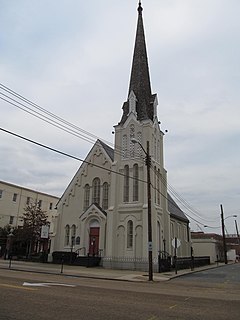
Downtown Portsmouth Historic District, also known as the High Street Corridor Historic District, is a national historic district located at Portsmouth, Virginia. It encompasses 229 contributing buildings, 1 contributing site, 4 contributing structures, and 1 contributing object in the central business district of Portsmouth. The district encompasses the original 1752 plan of the Town of Portsmouth and includes portions of expansions of the original boundaries dating to 1763 and 1909. It includes a variety of commercial, government, and institutional buildings, with most dating to the years around the turn of the 20th century. Notable buildings include the Captain Baird House, Vermillion Manor (1840), City Hall Building (1878), former United States Post Office (1907-1908), First Presbyterian Church (1877), First United Methodist Churches (1882), St. James Episcopal Church, Ebenezer Baptist Church, YMCA building, Tidewater Building, Southern Aid Building, Colony Theater, Lyric Theater, Blumberg's Department Store, Mutual Drug Company (1946), the New Kirn Building, and the Professional Building. Separately listed are the Commodore Theatre, Portsmouth Courthouse, Pythian Castle, St. Paul's Catholic Church, and Trinity Episcopal Church

Driver Historic District is a national historic district located at Suffolk, Virginia. The district encompasses 20 contributing buildings in the crossroads community of Driver in Suffolk. The district includes eight residences, two churches, two school structures, a train depot, a lodge, an outbuilding, and five commercial structures. They are in a variety of popular 19th and early-20th century architectural styles including Federal, Queen Anne, and Colonial Revival. Notable buildings include the Parker House (1820-1840), Norfolk and Carolina Railroad depot and station master's house, Brannon House, Arthur's Store, Randy's Rods, Driver Variety Store, Beech Grove United Methodist Church, Berea Congregational Christian Church, Dejarnette High School (1926), and Harmony Lodge #149 (1938).

West End Historic District is a national historic district located at Suffolk, Virginia. The district encompasses 201 contributing buildings and 93 contributing structures in a primarily residential section of the city of Suffolk. The district includes buildings dating from the last decade of the 19th century through the first four decades of the 20th century in a variety of popular architectural styles including Queen Anne and Folk Victorian. The residences were developed to support the growing upper-, middle-, and working-class populations. Notable buildings include the J. C. Causey, Jr. House, Oxford United Methodist Church (1922), and West End Baptist Church (1938).






























